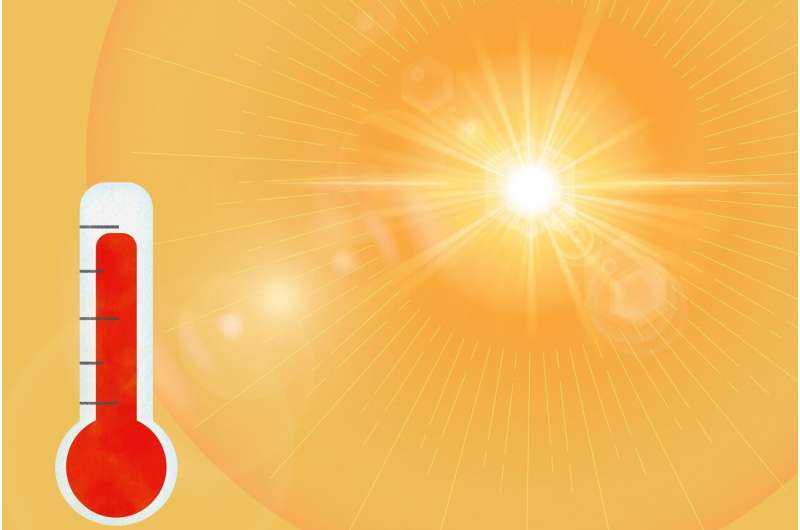This article has been reviewed according to Science X's editorial process and policies. Editors have highlighted the following attributes while ensuring the content's credibility:
fact-checked
peer-reviewed publication
trusted source
proofread
High ambient temperature in pregnancy associated with childhood leukemia

As climate change warms the planet, high ambient temperatures are expected to be more common and intense over the coming decades in the U.S. and worldwide.
Researchers from the Yale School of Public Health (YSPH) have studied how rising temperatures adversely affect human health. A study appearing in The Lancet Planetary Health journal finds that exposure to high ambient temperatures during pregnancy can have detrimental impact on the health of the offspring.
This is the first study that directly evaluates the association between hot temperatures during pregnancy and the risk of cancer in children.
"Our study is adding to a growing body of literature that underscores that high ambient temperature not only has immediate health effects, but also may be a cause of future chronic diseases," said Tormod Rogne, the study's first author and assistant professor of epidemiology at YSPH.
The researchers looked at acute lymphoblastic leukemia (ALL), the most common type of malignancy in children whose incidence has been increasing for decades. In the U.S., ALL disproportionately affects Latino children.
Previous scientific research has established that most cases of childhood ALL have a prenatal origin. Environmental exposures during pregnancy, such as air pollution, have been linked to an increased risk of childhood ALL.
"Exposure during the first trimester is suspected to be the most critical because this is when the most profound developmental alterations in hematopoiesis occur," said Xiaomei Ma, senior author and professor of epidemiology, referring to blood cell production.
"There are multiple reasons to suspect that maternal exposure to high ambient temperature may initiate the pathogenesis of ALL in fetal life," added Rogne.
ALL, a rare childhood cancer
According to the American Cancer Society, leukemia is the most common type of cancer in children and adolescents, accounting for almost one out of three cancers. Overall, however, childhood leukemia is a rare disease. Rogne said that Latino children have a 30–40% increased risk of ALL compared with non-Latino white children. ALL is more common in boys than in girls, the cancer society notes.
Racial and ethnic minority groups experience a disproportionate burden of heat exposure, in part due to their line of work and residential segregation. A recent YSPH study has shown that people living in segregated communities are more vulnerable to heat.
"It is increasingly clear that high ambient temperature during pregnancy has negative effects on birth outcomes, especially in racial and ethnic minority groups," the researchers wrote. "However, very little is known about the longer-term outcomes for the offspring as a consequence of exposure to high ambient temperature during pregnancy."
Temperature increase linked to a higher risk
The research team used data from California birth records and the California Cancer Registry, allowing them to identify ALL cases diagnosed in children 14 years and younger. The association between ambient temperature and ALL was evaluated per gestational week and was focused on the warm weather months from May through September.
The study included 6,258 children with ALL and 307,579 children without. The greatest association between ambient temperature and risk of ALL was observed in gestational week eight, which is in the middle of the first trimester of pregnancy.
In this week, a mean weekly temperature of 30 degrees Celsius (86 degrees Fahrenheit) was associated with an almost doubled risk of ALL compared with a mean weekly temperature of 10 degrees Celsius (50 degrees Fahrenheit).
This analysis used the California Linkage Study of Early-Onset Cancers, a population-based, statewide study that included children born in California during 1982–2015 and diagnosed with cancer in California during 1988–2015. Information on cancer status was gathered from the California Cancer Registry, and birth records from the Center for Health Statistics and Informatics, both within the California Department of Public Health.
Exposure to ambient temperature was estimated from NASA's Daily Surface Weather Data for North America. The researchers also reviewed birth records to gather information about their study population such as gestational age at birth, date of birth, race, ethnicity, sex, birth order, maternal and paternal ages, maternal education, birth weight, and mode of delivery.
It is currently not clear what potential mechanisms may underlie the link between ambient heat exposure in pregnancy and ALL in the offspring. The authors hypothesize that it may in part be through epigenetic changes, inflammation, or oxidative stress.
More information: Tormod Rogne et al, High ambient temperature in pregnancy and risk of childhood acute lymphoblastic leukaemia: an observational study, The Lancet Planetary Health (2024). DOI: 10.1016/S2542-5196(24)00121-9



















